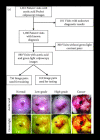Multicontrast Pocket Colposcopy Cervical Cancer Diagnostic Algorithm for Referral Populations
- PMID: 37850189
- PMCID: PMC10521679
- DOI: 10.34133/2022/9823184
Multicontrast Pocket Colposcopy Cervical Cancer Diagnostic Algorithm for Referral Populations
Abstract
Objective and Impact Statement. We use deep learning models to classify cervix images-collected with a low-cost, portable Pocket colposcope-with biopsy-confirmed high-grade precancer and cancer. We boost classification performance on a screened-positive population by using a class-balanced loss and incorporating green-light colposcopy image pairs, which come at no additional cost to the provider. Introduction. Because the majority of the 300,000 annual deaths due to cervical cancer occur in countries with low- or middle-Human Development Indices, an automated classification algorithm could overcome limitations caused by the low prevalence of trained professionals and diagnostic variability in provider visual interpretations. Methods. Our dataset consists of cervical images () from 880 patient visits. After optimizing the network architecture and incorporating a weighted loss function, we explore two methods of incorporating green light image pairs into the network to boost the classification performance and sensitivity of our model on a test set. Results. We achieve an area under the receiver-operator characteristic curve, sensitivity, and specificity of 0.87, 75%, and 88%, respectively. The addition of the class-balanced loss and green light cervical contrast to a Resnet-18 backbone results in a 2.5 times improvement in sensitivity. Conclusion. Our methodology, which has already been tested on a prescreened population, can boost classification performance and, in the future, be coupled with Pap smear or HPV triaging, thereby broadening access to early detection of precursor lesions before they advance to cancer.
Copyright © 2022 Erica Skerrett et al.
Conflict of interest statement
The authors declare that there are no conflicts of interest related to this article.
Figures






References
-
- Omone O. M., and Kozlovszky M., “HPV and cervical cancer screening awareness: a case-control study in Nigeria,” in 2020 IEEE 24th International Conference on Intelligent Engineering Systems (INES), Reykjavík, Iceland, 2020
-
- Fontham E. T. H., Wolf A. M. D., Church T. R., Etzioni R., Flowers C. R., Herzig A., Guerra C. E., Oeffinger K. C., Shih Y. C. T., Walter L. C., Kim J. J., Andrews K. S., DeSantis C. E., Fedewa S. A., Manassaram-Baptiste D., Saslow D., Wender R. C., and Smith R. A., “Cervical cancer screening for individuals at average risk: 2020 guideline update from the American Cancer Society,” CA: A Cancer Journal for Clinicians, vol. 70, no. 5, pp. 321–346, 2020 - PubMed
-
- Brisson M., Kim J. J., Canfell K., Drolet M., Gingras G., Burger E. A., Martin D., Simms K. T., Bénard É., Boily M. C., Sy S., Regan C., Keane A., Caruana M., Nguyen D. T. N., Smith M. A., Laprise J. F., Jit M., Alary M., Bray F., Fidarova E., Elsheikh F., Bloem P. J. N., Broutet N., and Hutubessy R., “Impact of HPV vaccination and cervical screening on cervical cancer elimination: a comparative modelling analysis in 78 low-income and lower- middle-income countries,” The Lancet, vol. 395, no. 10224, pp. 575–590, 2020 - PMC - PubMed
-
- Bradford L., and Goodman A., “Cervical cancer screening and prevention in low-resource settings,” Clinical Obstetrics and Gynecology, vol. 56, no. 1, pp. 76–87, 2013 - PubMed
Grants and funding
LinkOut - more resources
Full Text Sources
Research Materials

